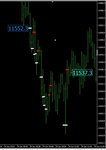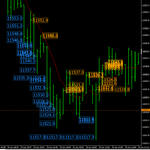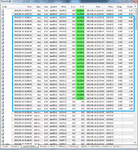You are using an out of date browser. It may not display this or other websites correctly.
You should upgrade or use an alternative browser.
You should upgrade or use an alternative browser.
I Stopped Using Stops
- Thread starter Wicked_Daddy
- Start date
- Watchers 48
darktone
Veteren member
- Messages
- 4,019
- Likes
- 1,086
Youll not likely find much agreement here re 'no stops' my friend. You see youre going up against some seriously deep seated beliefs.
See what I mean!
barjon
Legendary member
- Messages
- 10,752
- Likes
- 1,863
Quiz time:
This trader wanted to buy. The campaign starts at 52 and ends at 37.
How you suppose they make out?
whites buy 1 lot
reds sell 1 lot 'til the end where remaining 5 lots sold
about +30 overall
Attachments
f2calv
Experienced member
- Messages
- 1,318
- Likes
- 278
if you're willing to share, I'd be really interested to know how you do this. I'm familiar with the basic theory but, in practice, actually executing it successfully isn't that straight forward in my experience. An actual example, illustrated with charts if possible - would be really interesting and helpful.
@timsk firstly I apologise for having written a [conceited] phrase such as "I have a proven capability of hedging" which makes me sound a right prick
So hedging & pyramiding out of a losing position, I know it's not what others will classify as true hedging as I'm talking about taking opposing positions in the same market/instrument. For this to work you'll need a broker/market maker/bucketshop that allows you to trade in both directions at the same time, i.e. with IG I use the "force open" option.
No charts apply here, because it's just straightforward maths.
Scenario - You enter long £n/point, with a *mental* stop(hedge) of lets say 10 points, target irrelevant. For whatever reason the market moves quickly against you and you're 10 or more points in the red, at this point you create a new position in the opposite direction which for the sake of argument we'll call your hedge i.e. short £n/point.
Now you have £n/point long, £n/point short, 10 points in the red so looking at a total loss of £n*10.
At this point it's clear you got your first call wrong, and while now you've stopped your losses from mounting your net gain is still going to be zero.
Now I would wait, even walk away for a cuppa, until you have a clearer idea of short term market direction AND one of your positions is at least 10 points in the black.
Now you start by creating the pyramid by adding an additional position [either £n/point or less] in whichever direction is currently profitable. You also immediately add a stop at breakeven for the pyramided positions, so right now you've either got to wait for an additional 10 more points to go in favour of the pyramid for you to be at breakeven OR your pyramid will be stopped out for no loss to yourself and hopefully the market will reverse back in the direction of your original position.
Alternatively if you're greedy (which lets face it is what you got you into this mess in the first place) you can add more positions to the pyramid to start building profits if the move accelerates. You can close the losing position at your leisure, or leave it to "ride back down/up" after you have hopefully exited your winning pyramid near the top/bottom of the move.
It helps to look into the "minimum stop distance" for your broker, so you know how soon you can create the first and subsequent pyramid position and then be able to move the aggregated pyramid stop to breakeven.
And a slight tweak on the above method, the initial opposing trade/hedge can of course be less than £n, and you can scale up the opposing directional trade - which helps if the market suddenly can move back in your favour.
Also I do agree that hedging a losing position is simply replacing one problem with another [slightly more complicated] problem. But I would say, if you're sitting on a potential £500 loss because you've basically f'd up, I would personally like the opportunity to trade my way out of realising that loss.
Plus if the market goes sideways after you have created your hedge, which sods law dictates is often the case, if you're worried about the overnight financing charges for 1 or 2 nights - then I would say you you're far too precious about money and shouldn't be trading in the first place!
Hopefully the above helps in some way or other. :|
darktone
Veteren member
- Messages
- 4,019
- Likes
- 1,086
Result of that little endeavour was (take your pick) :-
+ 6.5 pts (relative to final size at 16 units)
+ 104.3 pts (relative to each unit, vendors like this one!)
Max size at any time 18 units
Ave position at final size 25.5
Scratches before final size -£7.80
Scratches after final size +£18.23
Result +£10.43
size play, erhmm:- 0,4,3,10,8,18,10,16,0
My view on the trade. It was a scratch. It never made it to a condition where I would have considered that I was taking profits, although the trip was profitable. I had to take my little girl to the dentist, hence hitting the market for the final few.. She was very brave! Bless her
What am I trying to convey? Its all very convenient for the stop advocates to consider the only other way is to hold n hope or get bigger to oblivion. Thats just not true.
If youve positioned x amount and its going against you can manage around the position at prices that are favourable to you. It doesnt really matter much how you do it as long as youre on the right side of the price rotation (selling high / buying low). The exact opposite of what a stop will do for you.
Iirc the OP mentioned a 200 point move against. Theres no need to sit with that. With a bit of management you might have scratched -100, -50, +50 (if shes rocking and rollin) by the time you discovered where the bottom really is, and youll be aved near it! Rather than whack , stop hit , whack , price fecks off in intended direction an all you got left is a bleeding heart! ahhhhh memories
Sure beats trying to be a price action zen master. Now, howd it go again?? Precognition wn it!! Fuᵓking Brilliant!
+ 6.5 pts (relative to final size at 16 units)
+ 104.3 pts (relative to each unit, vendors like this one!)
Max size at any time 18 units
Ave position at final size 25.5
Scratches before final size -£7.80
Scratches after final size +£18.23
Result +£10.43
size play, erhmm:- 0,4,3,10,8,18,10,16,0
My view on the trade. It was a scratch. It never made it to a condition where I would have considered that I was taking profits, although the trip was profitable. I had to take my little girl to the dentist, hence hitting the market for the final few.. She was very brave! Bless her
What am I trying to convey? Its all very convenient for the stop advocates to consider the only other way is to hold n hope or get bigger to oblivion. Thats just not true.
If youve positioned x amount and its going against you can manage around the position at prices that are favourable to you. It doesnt really matter much how you do it as long as youre on the right side of the price rotation (selling high / buying low). The exact opposite of what a stop will do for you.
Iirc the OP mentioned a 200 point move against. Theres no need to sit with that. With a bit of management you might have scratched -100, -50, +50 (if shes rocking and rollin) by the time you discovered where the bottom really is, and youll be aved near it! Rather than whack , stop hit , whack , price fecks off in intended direction an all you got left is a bleeding heart! ahhhhh memories
Sure beats trying to be a price action zen master. Now, howd it go again?? Precognition wn it!! Fuᵓking Brilliant!
Attachments
Last edited:
fxstrategist
Established member
- Messages
- 603
- Likes
- 17
I use stops, but I have seen some traders do well without stops, it all depends on your strategy and trading style.
new_trader
Legendary member
- Messages
- 6,770
- Likes
- 1,655
A penny for your thoughts!
A numbskull trades pennies/point and expects to be taken seriously in a discussion about using stops.
...it doesn't get dumber than that!
A numbskull trades pennies/point and expects to be taken seriously in a discussion about using stops.
...it doesn't get dumber than that!
timsk
Legendary member
- Messages
- 8,594
- Likes
- 3,320
That's a bit harsh n_t.A numbskull trades pennies/point and expects to be taken seriously in a discussion about using stops.
...it doesn't get dumber than that!
In my earlier post I suggested there were two alternatives to using conventional stops: a very long 'catastrophe' stop and some form of hedging strategy. tar added in options which I'd overlooked and now darktone has provided a 4th method - unless one classes his approach as a type of hedging strategy. I thought he illustrated his point rather well. I think many people will struggle with the sheer quantity of trades and their close proximity, but the principle is certainly worthy of consideration don't you think? Perhaps not for you personally, but in the context of the thread and the issues posed by the OP - darktone's post is a useful contribution, IMO.
The one element of it that I struggle with is this bit . . .
Whilst I agree with him that selling high / buying low is the exact opposite of what a stop will do, my feeling is that if one has the ability to do that and do it consistently well, then stops and their placement are unlikely to be that much of an issue.. . . It doesn't really matter much how you do it as long as you're on the right side of the price rotation (selling high / buying low). The exact opposite of what a stop will do for you. . .
Tim.
darktone
Veteren member
- Messages
- 4,019
- Likes
- 1,086
I am not sure not using stops....not using stops is sign of not accepting that anything can happen in the next future, which is the opposite mind frame of perceiving trading as a probability factor.
On the contrary, I see the other way, I accept fully:-
Ive no idea what the market will do next.
The market can do anything at any time.
My risk is my size x anything can happen.
That I know nothing.
-------------------------------
Two traders, both buying.
The markets at 500
Trader 1 has bought a line of 20 units at 500 with a stop at 480.
Trader 2 has stack 20 limits strung out down to 300.
The next price is 400!
Which trader has more realistic idea about what the can do and what risk they are actually at?
barjon
Legendary member
- Messages
- 10,752
- Likes
- 1,863
That's a bit harsh n_t.
In my earlier post I suggested there were two alternatives to using conventional stops: a very long 'catastrophe' stop and some form of hedging strategy. tar added in options which I'd overlooked and now darktone has provided a 4th method - unless one classes his approach as a type of hedging strategy. I thought he illustrated his point rather well. I think many people will struggle with the sheer quantity of trades and their close proximity, but the principle is certainly worthy of consideration don't you think? Perhaps not for you personally, but in the context of the thread and the issues posed by the OP - darktone's post is a useful contribution, IMO.
The one element of it that I struggle with is this bit . . .
Whilst I agree with him that selling high / buying low is the exact opposite of what a stop will do, my feeling is that if one has the ability to do that and do it consistently well, then stops and their placement are unlikely to be that much of an issue.
Tim.
mmm, like a lot of things I think Darktone's method works most of the time, but it won't help him when he finds himself in a strong adverse trend with no or minimal reactions.
In that scenario he has to call a halt somehow to constant additions and decide at what point he's going to take the accumulated loss. If he's got rules for that he has a de facto stop loss.
darktone
Veteren member
- Messages
- 4,019
- Likes
- 1,086
A numbskull trades pennies/point and expects to be taken seriously in a discussion about using stops.
...it doesn't get dumber than that!
Awww bless. This idjiot doesnt expect anything, except perhaps you to just be,,,well,,, you!
Did little old post number 6 touch a nerveywervey? In at 70 and 80 all just sound a bit familier.
Let me see now, 2 traders, both want £100 out the deal (or should I make it a £1000? Feel better?).
Joe bloggs in at 70 at 80. £100/10pts = 10ppp
Idjiot in at 35 and out at 80. £100/50pts = 2ppp
Joes the big dog right!:smart:
Sign me up for dumb please!:cheesy:
Last edited:
darktone
Veteren member
- Messages
- 4,019
- Likes
- 1,086
darktone's post is a useful contribution, IMO.
Jeeeez Tim, your asking nt if ive posted anything useful. Now thats a trade id take!!!!
The one element of it that I struggle with is this bit . . .
Whilst I agree with him that selling high / buying low is the exact opposite of what a stop will do, my feeling is that if one has the ability to do that and do it consistently well, then stops and their placement are unlikely to be that much of an issue.
Tim.
Imo thats not true, heres why.
You dont know where final high and low will end (although, some of us believe they do!!
With a stop not to be executed, you need to predict the future.
Last edited:
darktone
Veteren member
- Messages
- 4,019
- Likes
- 1,086
mmm, like a lot of things I think Darktone's method works most of the time, but it won't help him when he finds himself in a strong adverse trend with no or minimal reactions.
In that scenario he has to call a halt somehow to constant additions and decide at what point he's going to take the accumulated loss. If he's got rules for that he has a de facto stop loss.
Minimal reactions can still be dealt just not as favourably. You can also control your size as you see fit.
The most important thing is that the trader doesnt become unstable. Thats in the pysch department. Thats 90% of it in my book.
On the contrary, I see the other way, I accept fully:-
Ive no idea what the market will do next.
The market can do anything at any time.
My risk is my size x anything can happen.
That I know nothing.
-------------------------------
Two traders, both buying.
The markets at 500
Trader 1 has bought a line of 20 units at 500 with a stop at 480.
Trader 2 has stack 20 limits strung out down to 300.
The next price is 400!
Which trader has more realistic idea about what the can do and what risk they are actually at?
That is what I mean, not having a SL mean that you know what will happen and if you know you will lose not only financially...
tar
Legendary member
- Messages
- 10,443
- Likes
- 1,314
Averaging down in a small size is not the solution , you still need a stop , scale in or not that's fine but you need an exit strategy when in a loss . I have seen many traders wipeout years of profits trading that way . whether your entry is 11500 or the area 11000-11500 it doesn't matter at somepoint the market will move away from your comfort zone .
Last edited:
Similar threads
- Replies
- 5
- Views
- 1K




